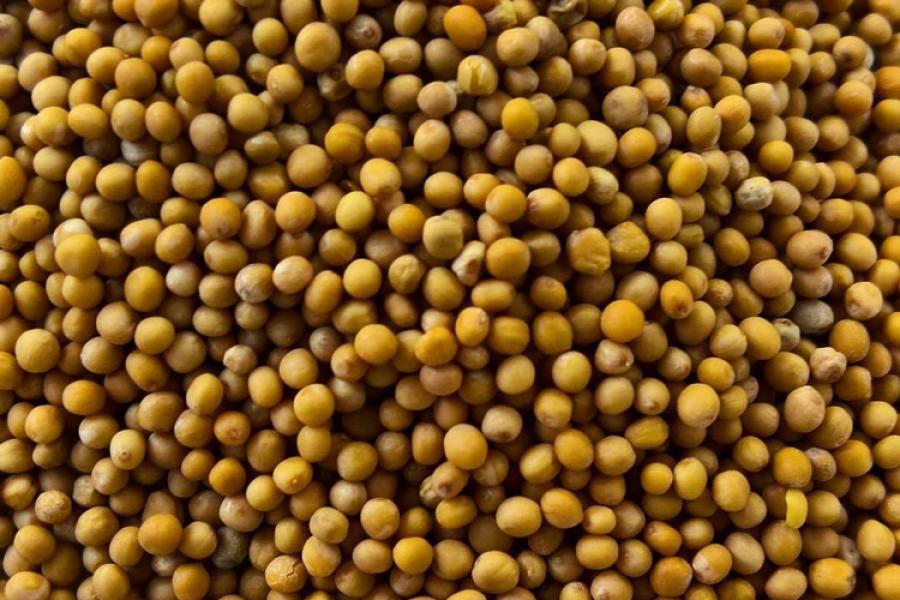Mustard seed & mustard
Mustard has a strong, hot pungent flavor. Used in sauces, served with meat, poultry, in deviled dishes, with eggs, in salad dressings; with cheese, in pickles and chutneys found in Indian curries, pickles, vegetarian dishes.
Mustard seeds come from a plant related to broccoli, Cabbage and Brussels sprouts. It has been known for centuries and used to season food or with medicinal purposes. The leaves, known as mustard greens, are edible and a popular soul food.
How to identify mustard
Seeds from one of the three types of mustard plans, annual herbaceus plants that grow 3-10 feet (1-3 m) high, has yellow flowers and carry long hairy pods with white (brassica alba) seeds, long smooth pods with black (brassica nigra) seeds, or even larger pods with brown (brassica juncea) seeds. The seeds are small and round and may come in white, light or dark brown, and black color. In the marketplace, mustard seeds can be found whole, ground to powder, or processed into one of the many prepared mustard blends.
Find the mildest flavor in white seeds, while the brown are stronger, ant the black are the strongest. Black seeds are difficult to find as they have been replaced by the brown variety, much easier to grow.
English mustard - bright yellow, from turmeric, mix of white and black seeds with wheat flour.
French mustard - black seeds with husks removed produce the pale yellow from Dijon mustard, ground wet with wine, salt and spices. For Bordeaux mustard black seeds make it dark in color and the wine, sugar, and tarragon make it sweet and sour. Moutarde a la ancienne is yellow to light brown and combines whole seeds with crushed ones, vinegar and spices.
American mustard - white seeds mixed mixed with wine or vinegar and sugar make it thinner and milder. It is hugely popular as a condiment for sandwiches.
Chinese mustard - usually smooth in texture and strong in flavor, probably the sharpest of all types of prepared mustard.
How to use and store
Ground mustard seeds are the base for a prepared mustard. Ground mustard keeps well when stored in a cool, dry place. Mix ground mustard with water to form a paste and stand for about 15 minutes to develop flavor.
A prepared mustard in a jar, such as Dijon, are best stored in the refrigerator once opened - just try to use them as they lose color and acquire a bitter taste if left for too long. Unopened, they can be stored in a cool, dark place for about 22-24 months.
Cooking with mustard
Mustard, either dry, whole seeds, freshly ground seeds, or prepared, is an ingredient in many sauces and salad dressings.
Use whole mustard seeds in pickling mixes.
Fry whole seeds and serve as garnish for Indian or South Asian dishes. Freshly ground seeds can be added to curries and spicy pastes.
Serve English mustard with beef, ham, gammon or pork; add it to sauces for fish and vegetables. Don't forget it when preparing Welsh rarebit, it is an important ingredient.
Accompany grilled steak and other grilled or roasted meats with Dijon mustard, and use it as an ingredient in a variety of sauces and salad dressings.
German mustard is the condiment of choice for German style sausages and cold meats. This mustard also adds flavor and zest to stews cooked in beer.
For a hot dogs, burgers and barbecued meats, ham, sandwiches and relishes, American mustard is the best choice.
Substitutions
Substitute 1 tsp dry mustard with:
- 1 Tbs prepared mustard - and decrease liquid in the recipe by 1tsp
- 1-2 tsp mustard seeds - grind if required.
Substitute 1 Tbs prepared mustard with:
- 1 tsp dry mustard + 1-2 tsp wine or vinegar
- 1-2 tsp mustard seeds
- 1 tsp caraway seeds
- 1 tsp prepared horseradish
- 1 tsp wasabi paste
Substitute 1 tsp mustard seeds with:
- 1/2-1 tsp dry mustard
- 1 Tbs prepared mustard and decrease liquid in the recipe by 1 tsp.
Facts
Mustard owes its name to the mixture of crushed mustard seeds and unfermented grape juice - must - prepared by Romans and known as mustum ardents or burning wine. The Romans introduced this paste to France during their occupation and France has become one of the largest producers of mustard, especially around Dijon. Dijon mustard counts for about half the world's mustard.
It is said than Alexander the Great sent to Darius, the mighty Persian general, a small sack of mustard seeds, meaning Greek soldiers were few but extremely fiery, in response to his challenge, delivered in the form of a sack of sesame seeds, meaning the Persian army counted with as many soldiers.
How to grow
Sow the seed in spring, in a sunny place outdoors and rich, moist soil. Seedlings may need thinning. Pods are harvested late in the summer, when they are almost, but not fully, ripe and the seeds should be left to dry in the pods.
brassica alba, brassica juncea, brassica nigra
(cruciferae)
Mustard.
French: moutarde.
German: senf.
Italian: mostarda.
Spanish: mostaza.

